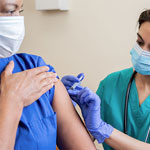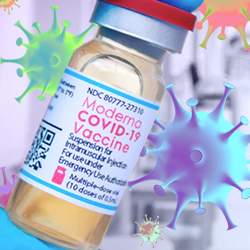By Marie Rosenthal, MS
Hospitals and other health care facilities should require employees to be vaccinated against COVID-19 because it “is the right thing to do for our community, our patients and for health care providers,” said David J. Weber, MD, MPH, the lead author of a consensus statement by the Society for Healthcare Epidemiology of America (SHEA) and six other organizations representing infectious diseases, infection prevention, pharmacy, pediatrics and long-term care (Infect Control Hosp Epidemiol 2021 Jul 13. doi:10.1017/ice.2021.322).
The statement recommends that COVID-19 vaccination be made a condition of employment at health care facilities across the country.

“The COVID-19 vaccines in use in the United States have been shown to be safe and effective,” said Dr. Weber, of the University of North Carolina at Chapel Hill and a member of the SHEA board of trustees. “By requiring vaccination as a condition of employment, we raise levels of vaccination for health care personnel, improve protection of our patients and aid in reaching community protection. As health care personnel, we’re committed to these goals.”
Panelist Ramy Elshaboury, PharmD, BCPS-AQ ID, of Massachusetts General Hospital, in Boston, told Infectious Disease Special Edition that the recommendation was an important step to ending the pandemic. “Advocating for high COVID-19 vaccination rates among health care personnel illustrates dedication to patient safety and community resiliency. COVID-19 vaccines are the single most successful intervention to date we can deploy to achieve these goals,” Dr. Elshaboury said.
Unfortunately, without mandates, vaccination uptake is subpar, according to Erica S. Shenoy, MD, PhD, of Massachusetts General Hospital and Harvard Medical School, in Boston.
“We have very good data that without vaccine being a condition of employment, it is very difficult to achieve the high levels of vaccination that we are looking for,” said Dr. Shenoy, a member of the panel. She pointed to the 2019-2020 influenza season, which saw health care worker uptake of 80% for the seasonal influenza vaccine, which is recommended by the CDC. The highest rate of compliance occurred among staff who worked in a facility that required vaccination.
“If you break that down by health care personnel who worked for employers who require it versus those who do not, there is quite a difference,” she said. “In those who required it, it was over 94% compliance; and in those who did not, it was around 69%.”
SHEA convened a panel of experts in infectious disease prevention, law and human resources to develop the position statement, which has also been endorsed by The Society for Post-Acute and Long-Term Care Medicine (AMDA), The Association for Professionals in Infection Control and Epidemiology (APIC), the Infectious Diseases Society of America (IDSA), the HIV Medicine Association (HIVMA), the Pediatric Infectious Diseases Society (PIDS), and the Society of Infectious Diseases Pharmacists (SIDP).
The panel conducted an eight-week review of evidence on the three vaccines that carry an emergency use authorization (EUA) from the FDA in the United States, vaccination rates and employment law to develop the statement.
The statement explains what to consider in developing a policy for COVID-19 vaccination as a condition of employment, including a thorough overview of the safety and efficacy of current vaccines, legal considerations, ways to engage stakeholders and improve vaccination rates before implementing a policy for vaccination as a condition of employment, and advantages of having a fully vaccinated workforce.
Panelist Hilary Babcock, MD, MPH, of Washington University School of Medicine, in St. Louis, said the panel looked at the existing mandates and requirements for vaccination among health care workers and concluded “that making this vaccination a condition of employment for health care workers does align with the [existing statutes].”
Some hospitals early on expressed concern about mandating the vaccine because it is being used under an EUA rather than an FDA approval, but the panel’s legal experts said they were within their rights to do so. However, Dr. Babcock recommended that “any organization that is contemplating a similar policy engage their legal team and their human resources department to be sure that they are in line with federal, as well as state and local, statutes and rules.”
The paper also specifies the need for exemptions for workers with medical contraindications and some other circumstances in compliance with federal and state laws. What constitutes an exemption must be clearly stated, the panel said, and there has to be a process for the employees who are seeking an exemption.
The paper does give advice to leadership on implementing and operationalizing the decision to make vaccination a condition of employment, according to Dr. Weber. “Anchoring principles of organizational leadership that are important to adhere to and display are assuring a transparent, consistent and clear message both in terms of the decision as well as in the implementation,” he said.
All decisions should be approached in a respectful, thoughtful and inclusive way, he added “Applying principles of diversity, equality and inclusion are examples of already existing principles with organizational leadership in addressing employees and medical staff among institutions.”
Trust and perception are paramount, according to Dr. Weber. “There are valid reasons for reservations that need to be addressed transparently,” he said.
According to one study of long-term care staff, safety concerns were the main reason for hesitancy among the staff (J AM Geratri Soc 2020 Dec 28 https://doi.org/10.1111/jgs.17022).
“First and foremost, listening is very important,” said Joshua Schaffzin, MD, PhD, of Cincinnati Children’s Hospital Medical Center. “People’s concerns are valid. Oftentimes education and information, and recognizing a concern’s validity and trying to allay those concerns are most effective [at persuading people to be vaccinated].”
The panel members said they felt now was the right time to issue the recommendation because they are very concerned about the most recent surge and the quick spread of the new variants, particularly the Delta variant. “There are several issues about the Delta variant; it is much more transmissible and deadly,” Dr. Weber explained. “There is a higher risk of hospitalizations from this variant and most rapid spread is occurring in those states that have the highest percentage of unvaccinated people.
“So, this is a good time to be pushing vaccination to the general public, first of all, to protect themselves from this highly transmissible, more dangerous pathogen, but also to be protecting our health care providers, because we will frequently have exposure to patients with known or suspected disease,” Dr. Weber said.
The Delta variant swept quickly through India, where it originated, and caused a surge of cases in Great Britain. It was first identified in the United States in March, and in just a few months became the dominant strain in this country. After months of steadily decreasing cases, the country is seeing an uptake due to the Delta variant. Most new cases are in unvaccinated people.
Studies have demonstrated that the COVID-19 vaccines authorized for use in the United States also protect against variants, and are particularly effective against severe disease, hospitalization and death. Despite this positive data, there are still many health care professionals who have declined to be vaccinated against COVID-19, the panel said.
“Vaccinating the health care workforce reduces the risk of transmission by protecting patients, health care personnel and communities, and maintains trust in health care providers and health care institutions,” Dr. Weber said.



